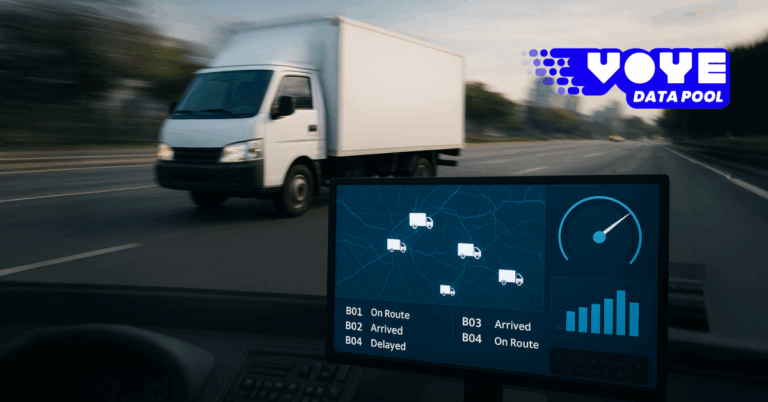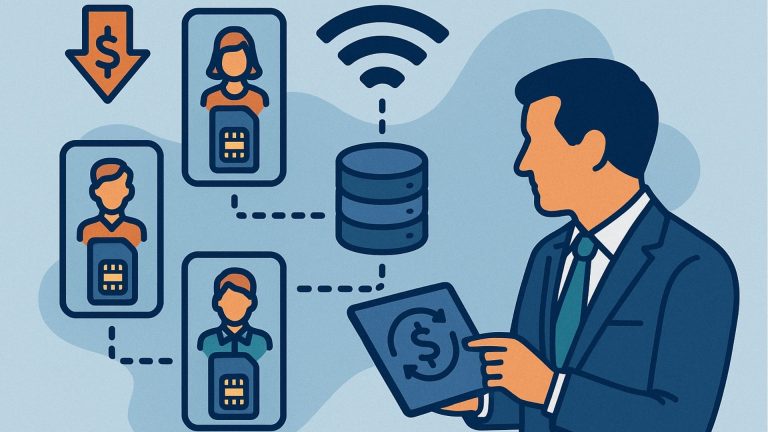Enterprise Mobility in 2025: Rethinking Connectivity for a Distributed Workforce
Enterprise mobility is evolving rapidly as organizations adapt to a more distributed and digital-first workforce. Seamless connectivity, cloud integration, and secure mobile access are redefining how teams collaborate across borders. This blog explores emerging trends, technologies, and strategies that empower businesses to stay agile and connected in the modern era of work.

In just a few years, enterprise mobility has shifted from a workplace perk to a core operating system for modern business. The distributed workforce is no longer a contingency plan or a stopgap—it’s a durable competitive advantage. Field teams, consultants, sales reps, technicians, creators, and executives all expect secure, high-speed mobile data wherever work happens. Meanwhile, IT leaders are measured on resilience, visibility, compliance, and cost control across a global fleet of devices that changes every quarter.
2025 is the year mobility strategies mature. The focus is moving from device provisioning and expense management to business outcomes: faster time to market, reliable customer experiences at the edge, and hardened security with verifiable governance. This article explores the state of enterprise mobility in 2025, the architectural decisions that matter, and how to build a connectivity layer that’s flexible, secure, and financially disciplined—especially for organizations with frequent international travel.
Throughout, we’ll reference Voye Data Pool—a platform that lets you instantly activate, manage, and monitor global eSIMs for your staff from one secure console. It’s a purpose-built connectivity layer for distributed teams traveling abroad and brands enhancing traveler experiences across 130+ countries.
Why mobility is a board-level topic in 2025
Mobility is now inseparable from revenue. Consider four patterns that define the year:
- Work is multi-modal. Hybrid and fieldwork dominate. A single employee may shift between home Wi-Fi, office Ethernet, hotel networks, public hotspots, and mobile data in a single day. The network perimeter is vaporized, and identity-driven, device-aware policies become the only reliable control plane.
- The edge is where customers meet you. Retail queues, pop-up clinics, airport kiosks, outdoor events, remote job sites—each depends on zero-downtime connectivity to transact, verify identity, render personalization, and gather telemetry in real time.
- International travel quietly returned to volume. Sales, implementation, support, and leadership teams are back on planes. The difference: they carry multiple eSIM profiles instead of plastic SIMs, expect activation in minutes, and want their usage to auto-optimize without friction or IT tickets.
- CFO scrutiny is intense. Spiky roaming bills, fragmented vendor contracts, and opaque overages are out of tolerance. Finance expects predictable unit economics and clear budget caps without sacrificing performance or coverage.
The short version: mobility is no longer an IT expense to “keep low.” It is a platform capability to architect well.
Core design principles for modern enterprise mobility
Principle A: Identity is the new perimeter
Treat user identity + device posture as the gatekeeper for network access. Pair your IdP (SSO/MFA), mobile device management (MDM/UEM), and connectivity provider so the same policies that govern SaaS access also govern data usage and hotspot behavior. When identity changes (role, risk, status), network privileges should adjust automatically.
Principle B: Connectivity must be abstracted
Enterprises shouldn’t hard-code to a single carrier’s footprint. Instead, orchestrate eSIMs across networks and countries under one policy engine. Abstraction lets you swap coverage, optimize cost, and keep business continuity if a local carrier degrades.
Principle C: Observability beats guesswork
You can’t secure or optimize what you can’t see. Aim for per-user, per-device, per-country analytics: data volume, session patterns, top apps, anomaly flags, and roaming trends—exportable to SIEM/BI tools. Real-time dashboards plus historical baselines support both security and finance.
Principle D: “Secure by default,” not “secure if configured”
Zero-trust assumptions, encrypted transports, minimal local data, automatic revocation on device loss, and least-privilege defaults. Configuration debt is the enemy; make secure defaults your standard, and automate variance away.
Principle E: Predictability is the path to trust
For global teams, “it might work” is not a plan. Use data pools with limits, proactive usage alerts, and automatic top-ups (with approvals) to protect experiences and budgets simultaneously.

Seamless eSIM Connectivity for Enterprises
Activate, manage, and scale eSIMs with ease.
The 2025 toolchain: What’s table stakes and what’s emerging
Table stakes (you likely have these—but are they integrated?)
- UEM/MDM: Device enrollment, policy enforcement, app distribution, remote wipe.
- IdP/SSO/MFA: Central identity plane for people and service accounts.
- Secure DNS / SWG / ZTNA: Threat defense and least-privilege access outside the office.
- Endpoint protection: EDR/XDR on laptops and mobile OS-appropriate controls.
- Expense management: Basic telecom reconciliation, cost centers, approval workflows.
Emerging standards you should be piloting now
- eSIM-first operations
Physical SIM logistics are too slow for distributed teams. eSIM lets IT provision in minutes, scale to new regions instantly, and retire access safely. With the right orchestration, you can pre-assign regional profiles, apply data caps by role, and move between networks without device swaps. - Connectivity as code
APIs for activation, assignment, and suspension enable automation: auto-provision data on trip approval, revoke on trip end, switch data pools for on-site events, and tag costs to the correct project—all without manual tickets. - Data-aware access policies
Integrating UEM and connectivity means you can say: “Corp-owned phone on current OS with encrypted storage gets full pool access; BYOD with unknown status gets a limited sandbox.” Contextual policies conserve data and reduce risk. - Private 5G / LTE & hybrid models
Not for everyone, but for large campuses, warehousing, logistics, and high-density venues, private 5G plus public carrier fallback yields deterministic performance for critical apps. - Generative AI copilots for mobility ops
Natural language queries like “Show top 10 travelers exceeding 80% of pool usage this week in EMEA” save hours. More importantly, copilots flag anomalies (a device that suddenly downloads 8 GB at 3 a.m. in a new country) and suggest guardrails.
Security and compliance without the handbrake
Security leaders want to reduce attack surface without blocking legitimate work. Four pragmatic moves:
- Minimize secrets on endpoints. Use short-lived tokens and avoid embedding credentials into mobile apps.
- Harden tethering and hotspot policies. Allow on corporate devices with posture checks; disallow on BYOD when connected to sensitive systems.
- Encrypt everywhere. VPN is no longer the only answer, but ensure traffic to business apps is encrypted; combine with secure DNS to block known-bad destinations.
- Prove compliance. Auditors will ask for who accessed what, from where, using which device, and how much data was processed. Your mobility stack should export evidence-grade logs.
Privacy matters, too. For BYOD populations, keep work and personal profiles separate. Collect only what you need: app allowlists/denylists and data totals for billing, not personal content.
Cost discipline: How to tame global data spend in 2025
Roaming shock still happens—often after roadshows, emergency site visits, or when a team spins up a new region. The cure is better design, not stricter memos.
- Use shared data pools aligned to region, project, or team.
- Set hard and soft limits. Soft limits trigger alerts (e.g., 80%, 90%); hard limits pause or auto-top-up based on a rule/approval.
- Right-size plans dynamically. If a user consistently uses under 500 MB/month, move them to a lighter tier; heavy travelers get a bigger pool during project windows only.
- Tag usage to cost centers automatically. When data belongs to a project code in your ERP, charge-backs are smooth and budget owners self-govern.
- Cull zombie lines. eSIM makes this simpler—deactivate when an employee changes roles, leaves, or pauses travel.
BYOD vs. CYOD vs. COPE: Choosing the right operating model
- BYOD (Bring Your Own Device): Lower hardware cost, higher variability. Best paired with containerization and tight data limits.
- CYOD (Choose Your Own Device): Employees pick from an approved catalog. Easier to support; consistent radios and OS versions.
- COPE (Corporate-Owned, Personally Enabled): Strongest control for sensitive roles, still humane for employees with separate personal profiles.
- Temporary / contractor fleets: Lean hard on eSIM activation windows to grant just-in-time connectivity for the contract duration.
A mature program usually runs all three—BYOD for low-risk roles, CYOD for mainstream knowledge workers, and COPE for regulated, field, or executive roles.
What great looks like: A reference mobility architecture
- Identity plane (SSO/MFA) authenticates users and service accounts.
- UEM attests device posture (OS, encryption, jailbreak/root status).
- Connectivity orchestration (eSIM platform) assigns profiles and data pools by role/region.
- Policy layer (ZTNA/SWG/DNS) governs access to apps and the open internet.
- Observability streams real-time usage and security telemetry to SIEM/BI.
- Automation via APIs wires mobility into HRIS (joiners/movers/leavers), travel systems (trip windows), and finance (cost centers, approvals).
- Incident playbooks let IT remotely throttle, suspend, or reassign data when devices are lost or compromised.
Field stories: Where connectivity strategy changes outcomes
- Retail pop-ups at scale: Seasonal activations in multiple cities need instant LTE/5G for POS and loyalty signups. eSIM + shared pools avoid weeks of carrier contracting and day-one outages.
- Aviation & events: On-site teams require predictable uplink for scanning, ticketing, and comms. Pools with “burst lanes” handle peak hours without permanent plan inflation.
- Consulting sprints: Teams hopping between client sites and countries need zero-touch activation on arrival, with usage cleanly billed back to each client project.
- Healthcare outreach: Secure, compliant data for telehealth and EHR access in rural or temporary clinics. COPE devices with strict policies protect PHI while keeping care moving.
Measuring success: KPIs that matter in 2025
- Time-to-activate (minutes per traveler or device)
- Coverage success rate (connections without manual intervention by country)
- Usage predictability (variance vs. budget)
- Security posture compliance (devices meeting baseline)
- Support volume (tickets per 100 devices per month)
- Business impact (NPS at mobile touchpoints; transaction completion at edge sites)
When these KPIs trend in the right direction, mobility is no longer a concern—it is an enabler.
How Voye Data Pool fits: Connectivity that matches modern operating models
Voye Data Pool is designed for organizations that operate across borders and need a single, trustworthy plane of control for mobile data.
What you can do with Voye Data Pool
- Instant eSIM activation for staff devices without shipping plastic SIMs.
- Manage and monitor at scale from one secure platform—see who’s using what, where, and when.
- Data pools with cost limits so budgets are predictable; set alerts at 80/90/95%, pause or auto-top-up with rules.
- Role- and region-based policies: Sales in North America vs. field engineers in APAC get the right pools and guardrails automatically.
- Coverage in 130+ countries, so travelers land connected.
- Multi-user administration: delegate rights to regional IT while preserving central governance.
- API access to integrate with HRIS, travel approvals, UEM, and finance systems.
- Security-first defaults: revoke access on device loss, enforce tethering rules, and export usage logs for audits.
Typical outcomes
- Days to minutes activation cycles for traveling staff.
- Fewer billing surprises, because pools and limits align with real usage.
- Better traveler experience: employees land, scan, and work—no kiosk hunts, no store visits.
- Cleaner charge-backs: usage is tagged to projects/regions for accurate accounting.
- Happier security and compliance teams via unified logs and consistent policy enforcement.
Implementation blueprint: 30–60–90 days to value
First 30 days: Foundation
- Inventory devices and traveler personas. Map roles, regions, and expected monthly data ranges.
- Select pilot groups. Choose a mix of heavy travelers and field staff across two regions.
- Stand up Voye Data Pool. Connect SSO, set admin roles, create initial data pools, and define alerts/limits.
- Automate basics. Use APIs to trigger eSIM assignment on trip approval; suspend on trip end.
- Define KPIs. Baseline current activation time, roaming spend variance, and ticket volume.
Days 31–60: Integration
- UEM integration. Align data access with device posture.
- Finance workflows. Tag usage to cost centers; enable approval rules for top-ups.
- Security logging. Stream usage events to SIEM; create alerts for anomalies.
- Regional expansion. Add two more countries and a secondary data pool for events.
Days 61–90: Scale and optimize
- Extend to contractors and temporary teams with time-boxed eSIMs.
- Tune pool sizes based on real usage; right-size traveler tiers.
- Add self-service. Let local IT trigger approved activations without central tickets.
- Quarterly review. Compare KPIs vs. baseline; publish results to exec sponsors.
2025 checklist for mobility excellence
- eSIM-first provisioning across traveler and field personas
- Shared data pools with soft alerts and hard caps
- Identity + UEM + connectivity policy alignment
- Real-time analytics and SIEM export
- Automated joiner/mover/leaver flows for connectivity
- BYOD/CYOD/COPE segmentation with clear rules
- Finance integration for charge-backs and approvals
- Anomaly detection for usage spikes or location shifts
- Documented incident playbooks for loss/theft/compromise
- Quarterly KPI reviews with exec sponsors
Bringing it together: A strategy that scales
The demands of a distributed workforce are not going to simplify. 5G densification, richer apps, AI-powered workflows, and customer expectations at the edge all push your connectivity layer to do more, more often, in more places. The way through is architectural clarity:
- Identity-anchored access
- eSIM-first connectivity across borders
- Policy automation that meets people where they are
- Deep observability tied to security and finance
- A single control plane that can adapt as the business moves
Voye Data Pool exists to make that clarity operational. It lets you instantly activate, manage, and monitor global eSIMs for traveling employees, apply data pools with cost limits, and maintain a consistent, secure experience in 130+ countries—all from one platform your IT, security, and finance teams can trust.
When mobility is built this way, your workforce stops asking “Will I be able to connect?” and starts asking “What can we achieve now that we are always connected?”
Next steps
- Map your traveler personas and current spend hot spots.
- Pilot eSIM with a cross-functional cohort (sales, field ops, execs) in two regions.
- Integrate identity, UEM, and finance so policy and cost follow the person and project.
- Adopt Voye Data Pool to unify activation, monitoring, and control with data pools and budget guardrails.
- Publish the KPI delta—time-to-activate, coverage success, spend variance, ticket reduction—to make mobility wins visible.
Your distributed workforce is already writing the next chapter of your business. Give them a connectivity foundation that moves just as fast.



 12 min read
12 min read





